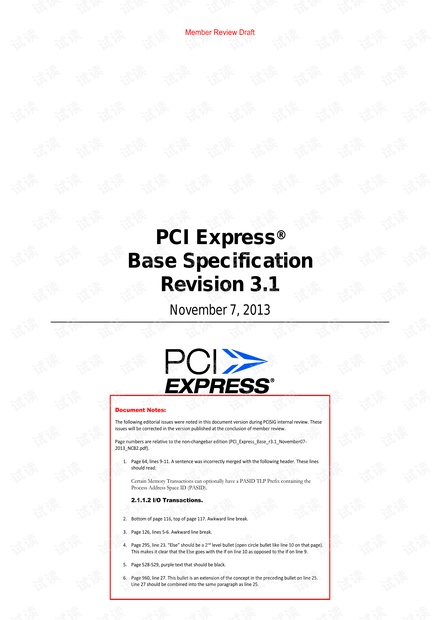没有合适的资源?快使用搜索试试~ 我知道了~
PCI Express_Base SPEC
需积分: 13 2 下载量 49 浏览量
2018-10-20
16:47:15
上传
评论
收藏 17.07MB PDF 举报
温馨提示
The following editorial issues were noted in this document version during PCISIG internal review. These issues will be corrected in the version published at the conclusion of member review.
资源推荐
资源详情
资源评论

PCI Express
®
Base Specification
Revision 3.1
November 7, 2013
Member Review Draft
Document Notes:
The following editorial issues were noted in this document version during PCISIG internal review. These
issues will be corrected in the version published at the conclusion of member review.
Page numbers are relative to the non-changebar edition (PCI_Express_Base_r3.1_November07-
2013_NCB2.pdf).
1. Page 64, lines 9-11. A sentence was incorrectly merged with the following header. These lines
should read:
Certain Memory Transactions can optionally have a PASID TLP Prefix containing the
Process Address Space ID (PASID).
2.1.1.2 I/O Transactions.
2. Bottom of page 116, top of page 117. Awkward line break.
3. Page 126, lines 5-6. Awkward line break.
4. Page 295, line 23. “Else” should be a 2
nd
level bullet (open circle bullet like line 10 on that page).
This makes it clear that the Else goes with the If on line 10 as opposed to the If on line 9.
5. Page 528-529, purple text that should be black.
6. Page 960, line 27. This bullet is an extension of the concept in the preceding bullet on line 25.
Line 27 should be combined into the same paragraph as line 25.

2
Revision Revision History DATE
1.0
Initial release.
07/22/2002
1.0a
Incorporated Errata C1-C66 and E1-E4.17.
04/15/2003
1.1
Incorporated approved Errata and ECNs.
03/28/2005
2.0
Added 5.0 GT/s data rate and incorporated approved Errata and ECNs.
12/20/2006
2.1 Incorporated Errata for the PCI Express Base Specification, Rev. 2.0
(February 27, 2009), and added the following ECNs:
• Internal Error Reporting ECN (April 24, 2008)
• Multicast ECN (December 14, 2007, approved by PWG May 8, 2008)
• Atomic Operations ECN (January 15, 2008, approved by PWG April 17, 2008)
• Resizable BAR Capability ECN (January 22, 2008, updated and approved by
PWG April 24, 2008)
• Dynamic Power Allocation ECN (May 24, 2008)
• ID-Based Ordering ECN (January 16, 2008, updated 29 May 2008)
• Latency Tolerance Reporting ECN (22 January 2008, updated 14 August 2008)
• Alternative Routing-ID Interpretation (ARI) ECN (August 7, 2006, last updated
June 4, 2007)
• Extended Tag Enable Default ECN (September 5, 2008)
• TLP Processing Hints ECN (September 11, 2008)
•
TLP Prefix ECN (December 15, 2008)
03/04/2009
3.0
Added 8.0 GT/s data rate, latest approved Errata, and the following ECNs:
• Optimized Buffer Flush/Fill ECN (8 February 2008, updated 30 April 2009)
• ASPM Optionality ECN (June 19, 2009, approved by the PWG August 20, 2009)
• Incorporated End-End TLP Changes for RCs ECN (26 May 2010) and Protocol
Multiplexing ECN (17 June 2010)
11/10/2010
3.1 Incorporated Errata for the PCI Express® Base Specification Revision 3.0
(November 7, 2013)
Incorporated the following ECNs:
• ECN: Downstream Port containment (DPC)
• ECN: Separate Refclk Independent SSC (SRIS) Architecture
• ECN: Process Address Space ID (PASID)
• ECN: Lightweight Notification (LN) Protocol
• ECN: Precision Time Measurement
• ECN: Enhanced DPC (eDPC)
• ECN: 8.0 GT/s Receiver Impedance
• ECN: L1 PM Substates with CLKREQ
• ECN: Change Root Complex Event Collector Class Code
• ECN: M-PCIe
•
ECN: Readiness Notifications (RN)
11/7/2013
Member Review Draft

PCI EXPRESS BASE SPECIFICATION, REV. 3.1
3
PCI-SIG
®
disclaims all warranties and liability for the use of this document and the information contained herein and
assumes no responsibility for any errors that may appear in this document, nor does PCI-SIG make a commitment to
update the information contained herein.
Contact the PCI-SIG office to obtain the latest revision of this specification.
Questions regarding the PCI Express Base Specification or membership in PCI-SIG may be forwarded to:
Membership Services
www.pcisig.com
E-mail: administration@pcisig.com
Phone: 503-619-0569
Fax: 503-644-6708
Technical Support
techsupp@pcisig.com
DISCLAIMER
This PCI Express Base Specification is provided “as is” with no warranties whatsoever, including any warranty of
merchantability, noninfringement, fitness for any particular purpose, or any warranty otherwise arising out of any
proposal, specification, or sample. PCI-SIG disclaims all liability for infringement of proprietary rights, relating to
use of information in this specification. No license, express or implied, by estoppel or otherwise, to any intellectual
property rights is granted herein.
PCI, PCI Express, PCIe, and PCI-SIG are trademarks or registered trademarks of PCI-SIG.
All other product names are trademarks, registered trademarks, or servicemarks of their respective owners.
Copyright © 2002-2013 PCI-SIG
Member Review Draft

PCI EXPRESS BASE SPECIFICATION, REV. 3.1
4
Contents
OBJECTIVE OF THE SPECIFICATION ............................................................................... 35
DOCUMENT ORGANIZATION.............................................................................................. 35
DOCUMENTATION CONVENTIONS ................................................................................... 35
TERMS AND ACRONYMS ...................................................................................................... 36
REFERENCE DOCUMENTS ................................................................................................... 44
1. INTRODUCTION............................................................................................................... 46
1.1. A THIRD GENERATION I/O INTERCONNECT ................................................................... 46
1.2. PCI EXPRESS LINK ......................................................................................................... 49
1.3. PCI EXPRESS FABRIC TOPOLOGY .................................................................................. 50
Root Complex ........................................................................................................ 50 1.3.1.
Endpoints .............................................................................................................. 51 1.3.2.
Switch .................................................................................................................... 54 1.3.3.
Root Complex Event Collector .............................................................................. 55 1.3.4.
PCI Express to PCI/PCI-X Bridge ........................................................................ 55 1.3.5.
1.4. PCI EXPRESS FABRIC TOPOLOGY CONFIGURATION ....................................................... 55
1.5. PCI EXPRESS LAYERING OVERVIEW .............................................................................. 56
Transaction Layer ................................................................................................. 57 1.5.1.
Data Link Layer .................................................................................................... 57 1.5.2.
Physical Layer ...................................................................................................... 58 1.5.3.
Layer Functions and Services ............................................................................... 58 1.5.4.
2.
TRANSACTION LAYER SPECIFICATION ................................................................. 62
2.1. TRANSACTION LAYER OVERVIEW .................................................................................. 62
Address Spaces, Transaction Types, and Usage ................................................... 63 2.1.1.
Packet Format Overview ...................................................................................... 65 2.1.2.
2.2.
TRANSACTION LAYER PROTOCOL - PACKET DEFINITION ............................................... 67
Common Packet Header Fields ............................................................................ 67 2.2.1.
TLPs with Data Payloads - Rules ......................................................................... 70 2.2.2.
TLP Digest Rules .................................................................................................. 74 2.2.3.
Routing and Addressing Rules .............................................................................. 74 2.2.4.
First/Last DW Byte Enables Rules ........................................................................ 78 2.2.5.
Transaction Descriptor ......................................................................................... 81 2.2.6.
Memory, I/O, and Configuration Request Rules ................................................... 87 2.2.7.
Message Request Rules ......................................................................................... 94 2.2.8.
Completion Rules ................................................................................................ 115 2.2.9.
TLP Prefix Rules ................................................................................................. 118 2.2.10.
2.3. HANDLING OF RECEIVED TLPS .................................................................................... 123
Request Handling Rules ...................................................................................... 126 2.3.1.
Completion Handling Rules ................................................................................ 138 2.3.2.
2.4. TRANSACTION ORDERING ............................................................................................ 142
Transaction Ordering Rules ............................................................................... 142 2.4.1.
Member Review Draft

PCI EXPRESS BASE SPECIFICATION, REV. 3.1
5
Update Ordering and Granularity Observed by a Read Transaction ................ 145 2.4.2.
Update Ordering and Granularity Provided by a Write Transaction ................ 146 2.4.3.
2.5. VIRTUAL CHANNEL (VC) MECHANISM ........................................................................ 147
Virtual Channel Identification (VC ID) .............................................................. 149 2.5.1.
TC to VC Mapping .............................................................................................. 150 2.5.2.
VC and TC Rules ................................................................................................. 151 2.5.3.
2.6. ORDERING AND RECEIVE BUFFER FLOW CONTROL ..................................................... 152
Flow Control Rules ............................................................................................. 153 2.6.1.
2.7. DATA INTEGRITY ......................................................................................................... 164
ECRC Rules ........................................................................................................ 164 2.7.1.
Error Forwarding ............................................................................................... 168 2.7.2.
2.8. COMPLETION TIMEOUT MECHANISM ........................................................................... 170
2.9. LINK STATUS DEPENDENCIES ...................................................................................... 171
Transaction Layer Behavior in DL_Down Status ............................................... 171 2.9.1.
Transaction Layer Behavior in DL_Up Status ................................................... 172 2.9.2.
Transaction Layer Behavior During Downstream Port Containment ............... 173 2.9.3.
3. DATA LINK LAYER SPECIFICATION ...................................................................... 175
3.1. DATA LINK LAYER OVERVIEW .................................................................................... 175
3.2. DATA LINK CONTROL AND MANAGEMENT STATE MACHINE ...................................... 177
Data Link Control and Management State Machine Rules ................................ 178 3.2.1.
3.3.
FLOW CONTROL INITIALIZATION PROTOCOL ............................................................... 180
Flow Control Initialization State Machine Rules ............................................... 181 3.3.1.
3.4. DATA LINK LAYER PACKETS (DLLPS) ........................................................................ 184
Data Link Layer Packet Rules ............................................................................ 184 3.4.1.
3.5. DATA INTEGRITY ......................................................................................................... 189
Introduction......................................................................................................... 189 3.5.1.
LCRC, Sequence Number, and Retry Management (TLP Transmitter).............. 189 3.5.2.
LCRC and Sequence Number (TLP Receiver) .................................................... 202 3.5.3.
4. PHYSICAL LAYER SPECIFICATION ........................................................................ 211
4.1. INTRODUCTION ............................................................................................................ 211
4.2. LOGICAL SUB-BLOCK ................................................................................................... 211
Encoding for 2.5 GT/s and 5.0 GT/s Data Rates ................................................ 212 4.2.1.
Encoding for 8.0 GT/s and Higher Data Rates................................................... 220 4.2.2.
Link Equalization Procedure for 8.0 GT/s Data Rate ........................................ 238 4.2.3.
Link Initialization and Training .......................................................................... 245 4.2.4.
Link Training and Status State Machine (LTSSM) Descriptions ........................ 264 4.2.5.
Link Training and Status State Rules .................................................................. 267 4.2.6.
Clock Tolerance Compensation .......................................................................... 332 4.2.7.
Compliance Pattern in 8b/10b Encoding ............................................................ 337 4.2.8.
Modified Compliance Pattern in 8b/10b Encoding ............................................ 338 4.2.9.
Compliance Pattern in 128b/130b Encoding ...................................................... 340 4.2.10.
Modified Compliance Pattern in 128b/130b Encoding ...................................... 342 4.2.11.
4.3. ELECTRICAL SUB-BLOCK ............................................................................................. 343
Electrical Specification Organization................................................................. 343 4.3.1.
Interoperability Criteria for 2.5, 5.0, and 8.0 GT/s Devices .............................. 343 4.3.2.
Member Review Draft
剩余1072页未读,继续阅读
资源评论


奔跑的蜗牛super
- 粉丝: 53
- 资源: 2
上传资源 快速赚钱
 我的内容管理
展开
我的内容管理
展开
 我的资源
快来上传第一个资源
我的资源
快来上传第一个资源
 我的收益 登录查看自己的收益
我的收益 登录查看自己的收益 我的积分
登录查看自己的积分
我的积分
登录查看自己的积分
 我的C币
登录后查看C币余额
我的C币
登录后查看C币余额
 我的收藏
我的收藏  我的下载
我的下载  下载帮助
下载帮助

 前往需求广场,查看用户热搜
前往需求广场,查看用户热搜最新资源
- S1017基于VUE+nodejs的点餐管理系统.zip
- 地理信息系统JTS库:空间分析与几何运算实现指南
- ESP8266+wifimanager库实现自动配网和时间天气显示
- windows计划任务python脚本调度器工具
- 产品销售网站源代码.zip
- 车辆管理系统源代码.zip
- S0079基于vue+SSM的“约球”足球类安卓app源码.zip
- win32汇编环境,对话框程序中复选框的一般操作示例
- 级联选择器,element-ui版本号 2.13.0
- VLC-Android-3.5.7-armeabi-v7a.apk
- sudo-1.9.16p2-1.ky10.x86-64.zip
- 3b113医疗用品销售网站_springboot+vue.zip
- 3b111研究生双选信息发布系统_springboot+vue.zip
- 3b112养老院管理系统_springboot+vue.zip
- 3b114医院病房信息管理系统_springboot+vue.zip
- 3b115基于JavaWeb的艺术摄影预约_springboot+vue0.zip
资源上传下载、课程学习等过程中有任何疑问或建议,欢迎提出宝贵意见哦~我们会及时处理!
点击此处反馈



安全验证
文档复制为VIP权益,开通VIP直接复制
 信息提交成功
信息提交成功